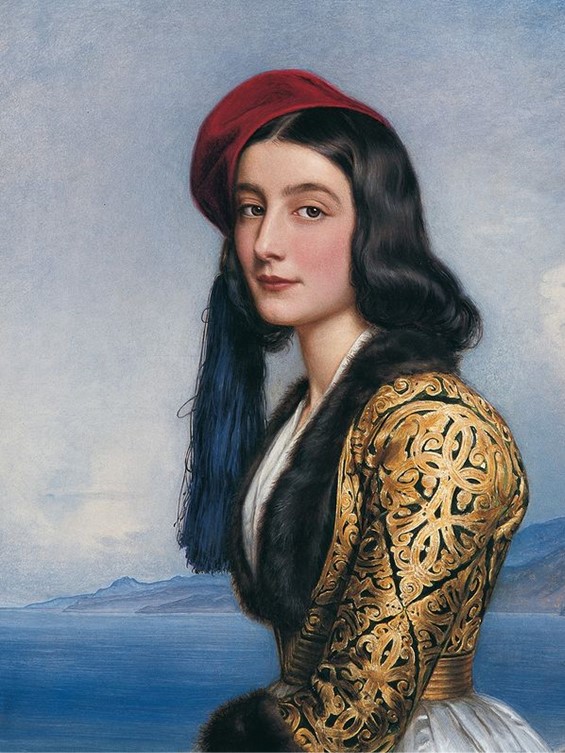
Katerina “Rosa” Botsaris, 1841, oil on canvas, 72,4 x 59 cm, Gallery of Beauties, Schönheiten-Galerie König Ludwig I, Nymphenburg Palace, Munich, Germany
https://commons.wikimedia.org/wiki/File:Portr%C3%A4t_von_Katharina_Botzaris.jpg
The diarist Christiane Lüth (1817–1900), whose husband was appointed personal chaplain to Queen Amalia of Greece wrote about Katerina “Rosa” Botsaris in her diaries: Of the two young ladies-in-waiting, Miss von Wiesenthau was not very well mannered, Catholic and not very pretty, although she talked constantly. The Greek, very beautiful Rosa Botzaris was not agreeable, but stingy and hated everything German. She was poor, but the glory which surrounded the name of her father, the freedom hero, Marko Botzaris, shone its light over her. When she travelled with the Queen, she was much celebrated for her beauty, which was highlighted by her national costume. She hid the fact that she understood the German language and spread dangerous political comments around her which much damaged Their Majesties, her benefactors. It is obvious Christiane Lüth did not like much, either of Queen Amalia’s Ladies in Waiting, but Rosa’s beauty is undisputed, and Joseph Karl Stieler’s Portrait of Katerina “Rosa” Botsaris is an excellent testimony! https://www.kathryngauci.com/blog-105-25-3-2021-a-literary-world-katerina-rosa-botsaris/
Between 1827 and 1850 Joseph Karl Stieler, court painter of Bavaria, was commissioned by King Ludwig I to create 36 portraits of the most beautiful women from the nobility and middle classes of Munich, Germany. These portraits were to decorate the south pavilion of Ludwig’s Nymphenburg Summer Palace. Among these very popular portraits was that of a Greek lady, Katerina “Rosa” Botsaris, the daughter of Markos Botsaris, the hero of the 1821 Greek Revolution. https://arrayedingold.blogspot.com/2011/11/gallery-of-beauties.html
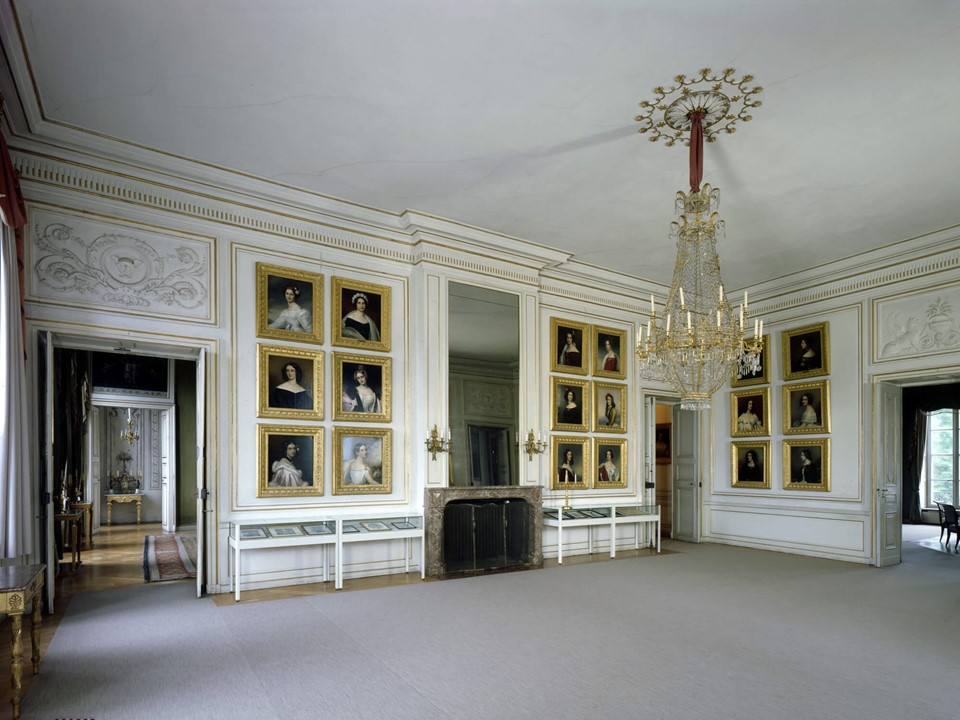
https://schloesserblog.bayern.de/residenz-muenchen/boese-maedchen-kommen-irgendwohin-gute-maedchen-kommen-an-die-wand-die-schoenheitengalerie-ludwigs-i
Katerina’s life was not easy. Born to the prominent Souliot Botsaris family, Katerina was the daughter of Chrysoula Kalogirou and Markos Botsaris, the famed, and revered leader of the Greek War of Independence, who died on the night of August the 8th, 1823, at Kefalobryso in Karpeisi, while with 450 Souliotes, ambushed the enemy camp of Mustafa Pasha of Shkoder (modern northern Albania) inflicting serious casualties. At the time, a child of 5 or 3 years old, Katerina Botsaris lived the life of a “hostage” in the city of Drama, at the harem of Dramali Mahmud Pasha, under the protection of upper-class Ottoman women. Katerina was apparently a particularly charming child, so much so that one of her “protectresses” wanted to officially adopt her. It was not meant to be, and during a prisoner exchange initiative, Katerina was returned to her family and reunited with her mother. Many “adventures” later, the orphaned family of Markos Botsaris settled at the newly created Greek state where members of the Botsaris family were to play an important role. https://archive.org/details/poikilstoaethni02raphgoog/page/n299/mode/2up?view=theater
While in Athens, the importance of the Botsaris name, her delightful personality, and great beauty attracted the attention of Amalia of Oldenburg, Queen of Greece from 1836 to 1862 as the spouse of King Otto (1815–1867), who appointed Katerina as her 1st Greek Lady-in-Waiting. In 1841, Katerina Botsaris accompanied Queen Amalia to Munich, the birthplace of King Otto of Greece. Tradition has it that upon arrival, as she was getting out of her carriage King Ludwig of Bavaria noticed Katerina’s Mediterranean beauty and hurried to assist her. Later on, the royal couple of Greece, Otto, and Amalia, suggested Katerina’s Portrait for the Gallery of Beauties, and King Ludwig wholeheartedly agreed. It is said that she was given the name Rosa, leaving behind her real name, from the ruby color of the rose … that her lips and cheeks had… https://www.bovary.gr/oramatistes/15798/roza-mpotsari-i-ellinida-kalloni-kori-toy-markoy-mpotsari-poy-emeine-sto-pantheon and https://www.patris.gr/2021/01/30/katerina-roza-mpotsari-i-kori-toy-iroa/
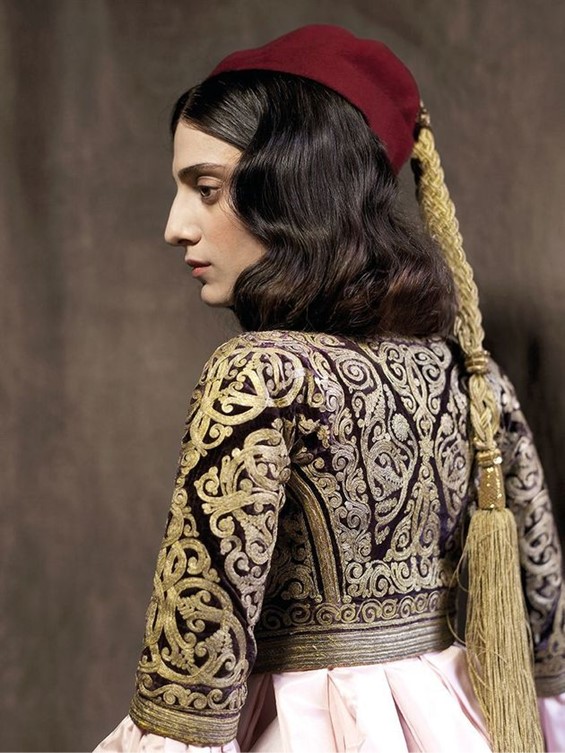
Photograph Credit: Christina Hilla Famel
https://www.huffingtonpost.gr/entry/endema-pseches-apo-te-foresia-tes-kera-frosenes-mechri-tes-rozas-mpotsare_gr_60f6b247e4b0e92dfebc53bb
Stieler’s Portrait of Katerina “Rosa” Botsaris shows a great Mediterranean beauty. Her complexion is glowing and creamy, her cheeks blushed with youth. High arched eyebrows frame a long straight nose and brown heavy-lidded eyes, which look out at us kindly, a light smile drawn at the corners of her mouth. Glossy chestnut hair flows down her neck, blending into the tassel of her jauntily placed hat and the fur collar of her jacket. She poses in front of the blue, tranquil Aegean Sea, and the pale blue but luminous Greek sky… a landscape that is atmospheric and tranquil, matching her character and demeanor. She wears an exquisite, fitted Kontogouni (vest)of crimson velvet, embroidered with gold cords, a crisp white Poukamisa (shirt), and a full, silk, pleated skirt, emphasizing her feminine shape. The Kontogouni survived time and it is still a prized treasure of the National History Museum of Greece. The artist Joseph Karl Stieler, trained in the Vienna Academy of Fine Arts and in the Parisian atelier of François Gérard, a student of Jacques-Louis David, created, inspired by the Greek beauty of Katerina “Rosa” Botsaris, the perfect example of a controlled and romanticized Neoclassical portrait. https://www.art-theoria.com/painting-of-the-month/katerina-rosa-botzaris/ and https://www.nationalgallery.gr/images/docs/books/athina-monacho.pdf pages 546-548
In 1845 Katerina “Rosa” Botsaris married Prince George Karatzas. a military man of Fanariot descent and had four children, two of whom died at a young age. The marriage was not particularly happy due to her husband’s strict and authoritarian character and the death of her children. The beautiful Souliotissa died at the age of 57 in January 1875. https://www.patris.gr/2021/01/30/katerina-roza-mpotsari-i-kori-toy-iroa/
Katerina Agrafioti wrote a book (in Greek) about Katerina’s life… the story of a woman who, always respecting her origin, unreservedly served the social “musts” and overlooked her personal pursuits with the power and dignity she derived from her father’s name.https://www.kathimerini.gr/opinion/707109/aikaterini-roza-mpotsari-sti-skia-toy-onomatos-mythistorimatiki-viografia-apo-tin-katerina-agrafioti-ekdoseis-papyros/ and https://www.ianos.gr/ekaterini-roza-mpotsari-sti-skia-tou-onomatos-0195564
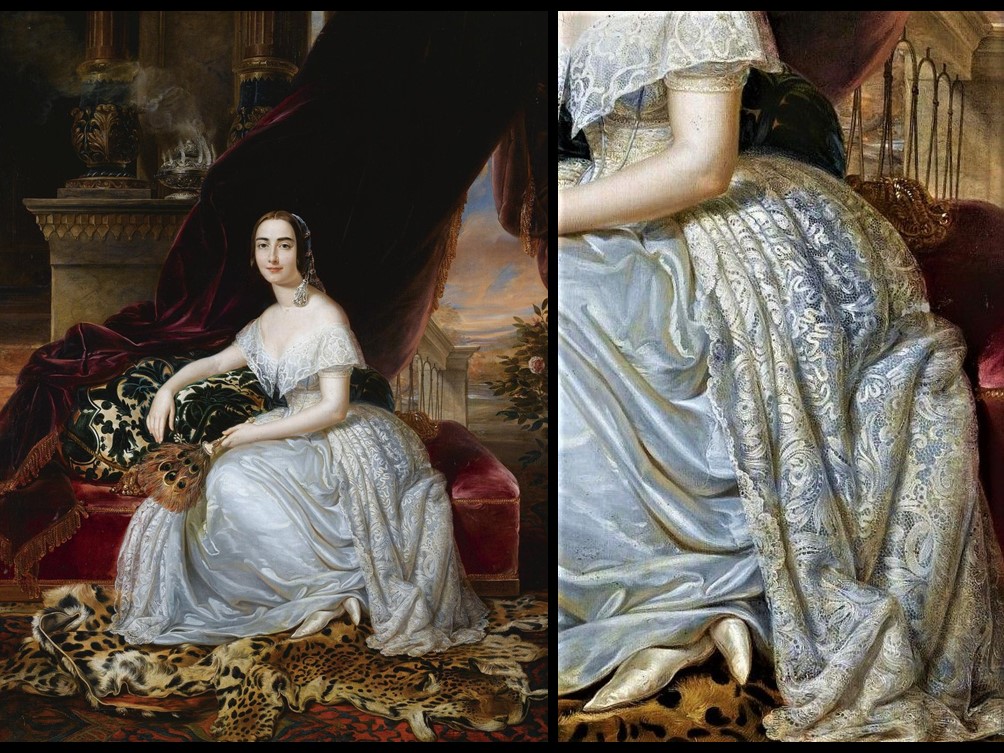
Ekaterini Botzaris Caradja, 1845, oil on canvas, 207×159 cm, Private Collection
https://commons.wikimedia.org/wiki/File:Ekaterini_Caradja_Botzaris.jpg
https://i.pinimg.com/originals/84/89/14/848914762a7727cfeb43a89aef41f647.jpg
A Damask Rose species bred in 1856, brightly white and very fragrant, was named Rosa Botsaris after her. https://garden.org/plants/view/415/Rose-Rosa-Botzaris/
For a Student Activity, please … Check HERE!
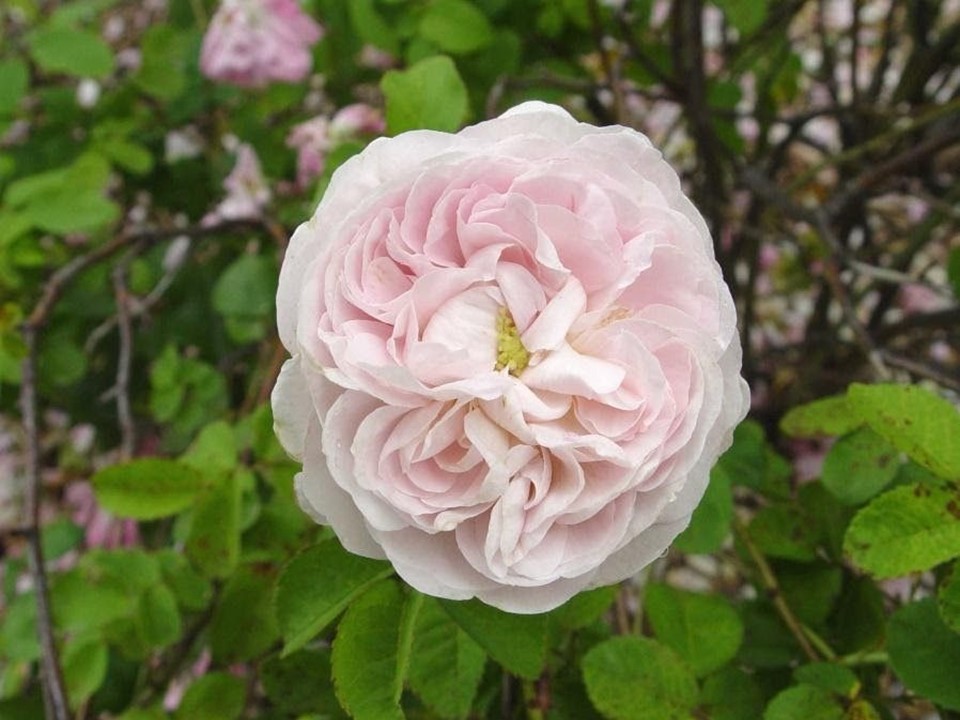
http://diolkos.blogspot.com/2011/07/blog-post_136.html